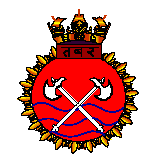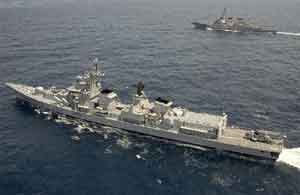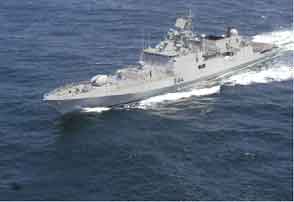Sea piracy: India wields the 'Battleaxe'
By By Shalini Amarnani | 21 Nov 2008
 With rapidly rising pirate attacks threatening to run merchant shipping out of the Suez Canal-Gulf of Aden zone and onto the longer, and economically unviable, route via Cape of Good Hope, the Indian Navy has struck a timely blow with its two recent interceptions of pirate vessels. In particular, the sinking of a pirate 'mother vessel' in the Gulf of Aden is now being hailed as a long-awaited response by patrolling naval ships against increasingly bold pirate attacks.
With rapidly rising pirate attacks threatening to run merchant shipping out of the Suez Canal-Gulf of Aden zone and onto the longer, and economically unviable, route via Cape of Good Hope, the Indian Navy has struck a timely blow with its two recent interceptions of pirate vessels. In particular, the sinking of a pirate 'mother vessel' in the Gulf of Aden is now being hailed as a long-awaited response by patrolling naval ships against increasingly bold pirate attacks.
Noel Choong, who heads the International Maritime Bureau's piracy reporting centre in Kuala Lumpur, Malaysia, warmly welcomed the tough Indian response. "It's about time that such a forceful action is taken. It's an action that everybody is waiting for," Choong said.
 Indian Naval Ship, INS Tabar (Battleaxe), intercepted a pirate 'mother vessel,' one which launches speedboats at target merchant vessels which are then boarded and hijacked for ransom, and sank it after a brief fire fight. These 'mother vessels' have been constantly referred to in piracy bulletins as the source of much of the pirate attacks emanating from Somali shores.
Indian Naval Ship, INS Tabar (Battleaxe), intercepted a pirate 'mother vessel,' one which launches speedboats at target merchant vessels which are then boarded and hijacked for ransom, and sank it after a brief fire fight. These 'mother vessels' have been constantly referred to in piracy bulletins as the source of much of the pirate attacks emanating from Somali shores.
Interestingly, this is the first reported encounter between a naval ship and a 'mother vessel.'
Even as INS Tabar's successful encounter has been greeted with a huge sense of relief by the merchant shipping community, and is sure to put a break on rapidly escalating pirate activity, albeit temporarily, navies from other countries have announced that they will boost their presence and operations against the pirates.
It now transpires that the Indian Navy has received sanction from the government to deploy another vessel in support of Tabar's operations. This is going to be another frontline naval ship, the 6,900 tonne Delhi-class destroyer, INS Mysore. Naval sources have confirmed that the government has also provided sanction for 'hot pursuit' of pirate vessels into Somali waters.
INS Tabar's action comes hard on the heels of a spectacular coup by pirates when they boarded and hijacked the Saudi-owned Sirius Star, carrying a cargo of 2 million barrels of oil, almost a quarter of Saudi Arabia's daily output, worth more than $ 100 million. This was shortly followed by news of the hijack of a cargo vessel operated by an Iranian firm.
Attacks taking a heavy toll
The heavy ocean traffic has been crippled by surge in sea piracy and a new breed of pirates, the bloodiest the world has seen.
The attack on Sirius Star is unusual in terms of location – it was attacked 450 nautical miles (830 km) off the Kenyan coast south of Somalia. It has also been the largest ship attacked so far.
The capture of such a large ship throws up the possibility of the pirates gaining in strength and joining forces.
There have been 83 attacks on ships off Somalia this year and counting, with 33 vessels hijacked and more than 200 crew still held captive. More than 1,200 Somalis are estimated to be involved, with six major groups active at sea.
Coalition forces in the region say that a force of 14 naval ships deployed by various forces, including India and Russia, are not enough to provide escorts to all commercial vessels plying trade routes in the region. It is estimated that more than 20,000 ships pass through the Gulf annually.
Besides Somalia the other pirate-ridden areas are the South China Sea, and the Malacca Strait between Indonesia and Malaysia.
The economic cost of piracy
 80 per cent of all international freight is transported by sea. More than 10 million cargo containers are moving across the world's oceans at any one time. Around 11 per cent of all tankers pass through the Gulf of Aden where the Somali pirates attack. Though navies of various countries have begun patrolling the Gulf of Aden to rein in the pirate gangs they have not won many battles here. Some of the international navies, including the Indian navy recently, have managed to fob off some attacks and even taken a few of the Somalian pirates into custody.
80 per cent of all international freight is transported by sea. More than 10 million cargo containers are moving across the world's oceans at any one time. Around 11 per cent of all tankers pass through the Gulf of Aden where the Somali pirates attack. Though navies of various countries have begun patrolling the Gulf of Aden to rein in the pirate gangs they have not won many battles here. Some of the international navies, including the Indian navy recently, have managed to fob off some attacks and even taken a few of the Somalian pirates into custody.
INS Tabar's is the most forceful blow struck so far and is certain to put a pause in pirate activity, albeit temporarily.
With the dangers at sea on the rise, ship owners have seen insurance premiums for coverage of passage through the Gulf of Aden climb 10 times from an average of $900 to $9,000.
If the incidents continue unabated, shipping vessels may opt to avoid the Gulf of Aden and take the longer route to Europe and North America round South Africa's Cape of Good Hope, which would almost certainly drive up commodity prices.
Ransom demands have risen steadily, as ship owners have little choice but to pay up after lengthy bargaining. Most captured ships are not released for less than $10,000, and the opening demand for larger vessels is now $2 million. Shipping companies frequently do not report attacks out of concern that it could increase insurance premiums. Authorities estimate that only half, or maybe even as few as a tenth, of pirate attacks are actually reported.
Piracy is estimated to cost $13 - 16 billion every year and could cost substantially more in coming years.
Showing the flag
Recently after prime minister Manmohan Singh's visit to the Gulf nation of Oman, a defence cooperation agreement was signed by both countries which, amongst other things, will also allow the Indian Navy (IN) berthing facilities. With this facility, Indian naval ships will now be able to patrol the strategically critical Gulf waters, which these days have also become pirate infested.
Also, very significant, are reports that an IN Dornier maritime reconnaissance aircraft may be stationed in Djibouti on the Horn of Africa, where France maintains a significant military base. The Dornier will provide the eye-in-the-sky facility to the IN and coalition forces and is destined to blunt pirate activity in the region as suspected vessels will now be targeted, and intercepted, before they can cause any damage.
There is also a proposal to increase the number of Indian warship patrolling the area to four, boosting the solo presence of INS Tabar. As mentioned earlier, INS Mysore is now already underway to join Tabar in the Gulf waters.
Discussions will also be initiated with other navies operating in the region for combined operations, naval headquarters has said.
Additionally, Russia and India will hold a joint naval exercise in the Indian Ocean in January next year. The two navies will conduct a number of maritime drills, including anti-piracy, terrorism and drug trafficking. Reports suggest that Russia too is set to boost its naval presence in the region.
| Major reported piracy incidents * In April 2008 pirates seized control of the French luxury yacht Le Ponant carrying 30 crew members off the coast of Somalia. The captives were released on payment of a ransom. The French military later captured some of the pirates, with the support of the provisional Somali government. * A Ukrainian ship, the MV Faina, containing an arms consignment for Kenya, including tanks and other heavy weapons. * MS Victoria flying under the Jordan flag was hijacked in May 2008. Ironically it was carrying sugar donated by Denmark as aid to Somalia. * The merchant vessel Iran's Deyanat. departed from China, was boarded by pirates off Somalia in September 2008 The ship's cargo was a matter of dispute, though some pirates have apparently, sickened, lost hair, suffered burns, and even died while on the ship. Speculations of chemical or even radioactive contents have been made. * M T Stolt Valor owned by a Japanese company and managed by Fleet Marine Ltd in Mumbai, was hijacked by the armed Somali pirates on 15 September. * MV TS COLOMBO, a 15,095 GRT container vessel, was attacked off the East coast of Somalia on 14 November. * MV CHEMSTAR VENUS, a Panamese flagged Chemical tanker (11,951GRT) was hijacked in the Gulf of Aden on 15 November.On 15 November 2008, Somali pirates seized the supertanker MV Sirius Star, 450 miles off the coast of Kenya. The ship was carrying around $100 million worth of oil and had a 25-man crew. This marked the largest tonnage vessel ever seized by pirates. * FV EKAWATNAVA 5 was hijacked on 18 November, and in relatively close proximity MV DELIGHT, a 25,768 GRT Bulk carrier was hijacked in the Gulf of Aden on 18 November. |







.webp)














